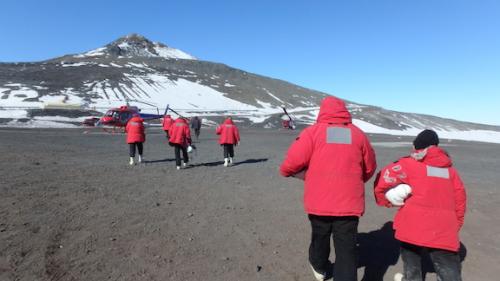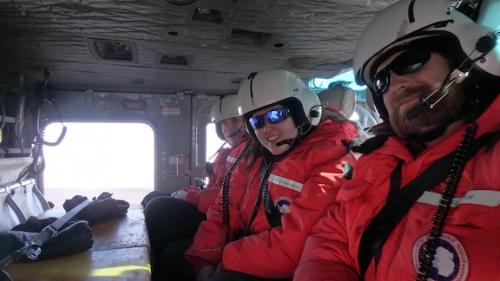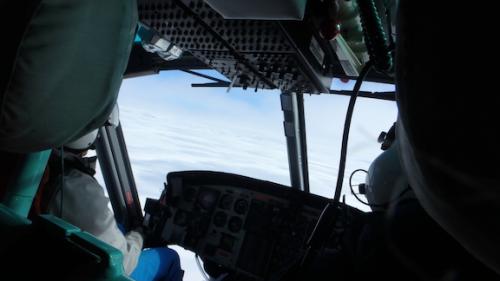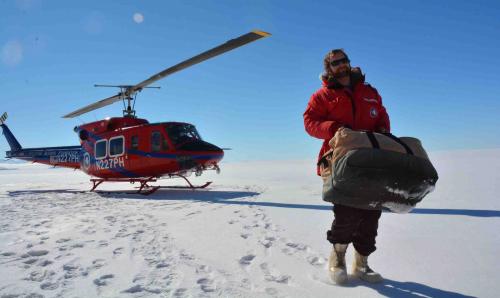 The team is lead out to our waiting Bell 212 "Twin Huey" helicopters for our flight to Granite Harbor.
The team is lead out to our waiting Bell 212 "Twin Huey" helicopters for our flight to Granite Harbor.
McMurdo Station Helicopter Operations - "Helo Ops" for short - flies five vehicles emblazoned with the red and blue color scheme of the US Antarctic Program. The three Bell 212 "Twin Hueys" and two AS-350-B2 "A-Stars" park on a volcanic gravel landing field just below Observation Hill at the southern end of the Station, their rotors tied down to the pad to hold them in place against the Antarctic winds. Helo Ops supports the 60 or so scientists who are working at field camps in the area. They shuttle personnel back and forth to Station as well as deliver and recover supplies in cargo packages known as "sling loads" hung beneath the aircraft.
 Half of Team Pycno, Steve Lane, Caitlin Shishido, and I, geared up and secured in the passenger compartment of one of the Bell 212s.
Half of Team Pycno, Steve Lane, Caitlin Shishido, and I, geared up and secured in the passenger compartment of one of the Bell 212s.
On the morning of our flight to Granite Harbor, we weigh and tag our dive gear, then load up our Pisten Bully for the short drive from the dive locker to the field where we unload everything into king-sized versions of radio flyer wagons. Wearing our ECW gear for the flight across the sea ice, we enter a passenger waiting room in the adjacent quonset hut, select a white plastic helmet from a nearby rack, then stand on a scale to get our "flight weight." Jenn, a helicopter technician with a noticeable southern accent, records these weights - proper loading of gear and passengers is essential aboard small aircraft - and briefs us on helicopter safety. In addition to the locations of fire extinguishers and exits, Jenn imparts other essential procedures such as only approaching the helo from the front and in sight of the pilot to avoid the dangerous tail rotor.
 Each Bell 212 is crewed by a pilot (right seat) and helicopter technician (left seat).
Each Bell 212 is crewed by a pilot (right seat) and helicopter technician (left seat).
With our gear loaded into two Bell 212s by the helo techs, Caitlin, Steve, and I follow Jenn out to our ride. We climb up into the main cabin, don our helmets, attach our intercom cables and buckle up. We listen through the headset as the pilot and tech in the front of the aircraft run through the startup checklist. The engines fire, the rotor begins to turn and a short time later, we're off. Traveling above the sea ice at 115mph/186kph, the ride is remarkably stable and smooth, though the engine noise makes speaking with Caitlin and Steve impossible. In the bright sunlight, our shadow glides over giant tabular icebergs and across sea ice cracks far below. Lounging Weddell seals lift their heads in curiosity. After an hour traversing the otherwise featureless sea ice, we've reached the plunging cliffs of Granite Harbor, 80mi/129km northwest of McMurdo. Fresh snow swirls in the afternoon sunlight as our helo lands. Once the rotor stops and engines shut down, our helo tech opens the sliding door and wordlessly, we begin unloading gear, turning our attention to our final dives in Antarctica.
 Once the helicopter lands, it's time to get to work (H. Arthur Woods, photo).
Once the helicopter lands, it's time to get to work (H. Arthur Woods, photo).

Comments